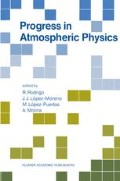Abstract
The contribution made by the undecayed component of the dayglow O2 (a1∆g) population to the nightglow O2(a1∆g-X3∑ -g ) IR atmospheric band emission is assessed. The time dependence of the evening twilight O2(a1∆g) production rates and the delayed response of the resulting IR atmospheric band emission is considered in some detail. The vestigial dayglow IR atmospheric band emission profiles expected under the conditions of a number of recent rocket-borne radiometer experiments are presented. These vestigial dayglow emission profiles are compared with those that have been previously estimated by Lopez-Moreno et al. (1986) and McDade et al. (1987) who employed much simpler kinetic models. The possible impact of differences between the present and the previously estimated vestigial emission rates upon our understanding of the nightglow IR atmospheric band excitation mechanisms is discussed.
Access this chapter
Tax calculation will be finalised at checkout
Purchases are for personal use only
Preview
Unable to display preview. Download preview PDF.
References
Ali, A.A., Ogryzlo, E.A., Shen, Y.Q. and Wassel, P.T. (1986) The formation of O2(a 1∆g) in homogeneous and heterogeneous atom recombination. Can.J.Phys. 64, 1614.
Allen, M., Lunine, J.L. and Yung, Y.L. (1984) The vertical distribution of ozone in the mesosphere and lower thermosphere. J.geophys.Res. 89, 4841.
Badger, R.M., Wright, A.C. and Whitlock, R.F. (1971) Absolute intensities of the discreet and continuous absorption bansa of oxygen gas at 1.26 and 1.065 µ and the radiative lifetime of the 1∆g state of oxygen. J.chem.Phys. 43, 4325.
Burch, D.E. and Gryvnak, D.A. (1969) Strengths, widths and shapes of the oxygen lines near 13,100 cm-1 (7620 Å).Appl.Opt. 8, 1493.
Campbell, I.M. and Gray, C.N. (1973) Rate constants for 0(3P) recombination and association with N(4S). Chem. phys. Lett. 8, 259.
Evans, W.F.J., Hunten, D.M., Llewellyn, E.J. and Vallance Jones, A. (1968) Altitude profile of the infrared atmospheric system of oxygen in the dayglow. J.geophys.Res. 73, 2885.
Evans, W.F.J. and Llewellyn, E.J.(1970) Molecular oxygen emissions in the airglow. Ann.Geophys. 26, 167.
Fairchild, C.E., Stone, E.J. and Lawrence, G.M. (1978) Photofragment spectroscopy of ozone in the UV region 270–310 nm and at 600 nm. J.chem.Phys. 69, 3632.
Findlay, F.D. and Snelling, D.R. (1971) Collisional deactivation of O2(1∆g). J.chem.Phys. 55, 545.
Gattinger, R.L. (1968) Observations and interpretation of the O2(1∆g -) 3∑- g) airglow emissions. Can.J.Phys. 46, 1613.
Greer, R.G.H., Murtagh, D.P., McDade, I.C., Dickinson, P.H.G., Thomas, L., Jenkins, D.B., Stegman, J., Llewellyn, E.J., Witt, G., Mackinnon, D.J. and Williams, E.R. (1986) ETON 1: a data base pertinent to the study of energy transfer in the oxygen nightglow. Planet.Space Sci. 34, 771.
Griggs, M. (1968) Absorption coefficients of ozone in the ultraviolet and visible regions. J.chem.Phys. 49, 857.
Han, R.Y., Megill, L.R. and Wyatt, C.L. (1973) Rocket observations of the equatorial O2(1∆g) emission after sunset. J.geophys.Res. 78, 6140.
Hedin, A.E. (1983) A revised thermospheric model based on mass spectrometer and incoherent scatter data: MSIS-83. J.geophys.Res. 88, 10170.
Kernahan, J.H. and Pang, H.L. (1975) Experimental determination of absolute A coefficients for “forbidden” atomic oxygen lines. Can.J.Phys. 53, 455.
Knickelbein, MLB., Marsh, K.L., Ulrich, O.E. and Busch, G.E. (1987) Energy transfer kinetics of singlet molecular oxygen: the deactivation channel for 02(b1∑+ g). J.chem.Phys. 87 ,2392.
Krupenie, P.H. (1972) The spectrum of molecular oxygen. J. chem. Phys.Ref.Data 1, 423.
Lee, L.C. and Slanger, T.G. (1978) Observations on 0(1D→3P) and 02(b1∑+ g→X3∑- g) following 02 photodissociation. J.chem.Phys. 69, 4053.
Lin, C.L. and Leu, M.T. (3 982) Temperature and third-body dependence of the rate constant for the reaction 0+02+M→03+M. Int.J.Chem.Kinet. 14, 417.
Lopez-Moreno, J.J., Rodrigo, R., and Vidal, S. (1985) Radiative contamination in rocket-borne infrared photometric measurements. J.geophys.Res. 90, 6617.
Lopez-Moreno, J.J, Molina, A., Lopez-Puertas, M., Moreno, F. and Rodrigo, R. (1986) Altitude distributions of some airglow features. Proc. 13th Annual Meeting on Atmospheric Studies by Optical Method (Oslo) (Edited by Maseide, R.), p.199.
Martin, L.R., Cohen, R.B. and Schatz, J.F. (1976) Quenching of laser induced fluorescence of 02(b1∑+ G) by 02 and N2. Chem.Phys.Lett. 41, 394.
McDade, I.C., Llewellyn, E.J., Greer, R.G.H. and Murtagh, D.P. (1987) ETON 6: a rocket measurement of the 02 infrared atmospheric (0–0) band in the nightglow. Planet.Space Sci. 35, 1541.
Mount, G.H. and Rottman, G.J. (1983) The solar absolute spectral irradiance 1150–3173 Å: May 17, 1982. J.geophys.Res. 88, 5403.
Nicolet, M. and Kennes, R. (1986) Aeronomic problems of the molecular oxygen photodissociation-I. The 02 Herzberg continuum. Planet.Space Sci. 34, 1043.
Rodrigo, R., Lopez-Moreno, J.J., Lopez-Puertas, M., Moreno, F. and Molina, A. (1986) Neutral atmospheric composition between 60 and 220 km: a theoretical model for mid-latitudes. Planet.Space Sci. 34, 723.
Streit, G.E., Howard, C.J., Schmeltekopf, A.L., Davidson, J.A. and Schiff, H.I. (1976) Temperature dependence of 0(1D) rate constants for reactions with 02, N2, C02, 03, and H20. J.chem.Phys. 65, 4761.
Thomas, R.J., Barth, C.A. and Solomon, S. (1984) Seasonal variations of ozone in the upper mesosphere and gravity waves. Geophys.Res.Lett. 11, 673.
Thomas, R.J. and Young, R.A. (1981) Measurements of atomic oxygen and related airglows in the lower thermosphere. J.geophys.Res. 86, 7389.
Vallance Jones, A. (1964) The telluric emission spectrum in the range 1 µ to 3 mm: introductory report. Mem. Soc. r. Sc. Liege 9, 289.
Wayne, R.P. (1984) Singlet oxygen airglow. J.Photochem. 25, 345.
Winick, J.R., Picard, R.H., Sharma, R.D. and Nadile, R.M. (1985) Oxygen singlet delta 1.58-micrometer (0–1) limb radiance in the upper stratosphere and lower mesosphere. J.geophys.Res. 90, 9804.
Author information
Authors and Affiliations
Editor information
Editors and Affiliations
Rights and permissions
Copyright information
© 1988 Kluwer Academic Publishers
About this chapter
Cite this chapter
McDade, I.C., Llewellyn, E.J. (1988). Rocket Measurements of the O2 Infrared Atmospheric (0-0) Band in the Nightglow: The Vestigial Dayglow Components. In: Rodrigo, R., López-Moreno, J.J., López-Puertas, M., Molina, A. (eds) Progress in Atmospheric Physics. Springer, Dordrecht. https://doi.org/10.1007/978-94-009-3009-4_11
Download citation
DOI: https://doi.org/10.1007/978-94-009-3009-4_11
Publisher Name: Springer, Dordrecht
Print ISBN: 978-94-010-7852-8
Online ISBN: 978-94-009-3009-4
eBook Packages: Springer Book Archive

